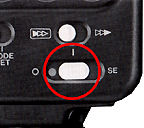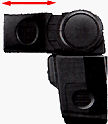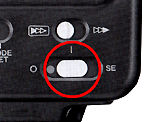File Size: HTML (28k) Loading....
The SE (Save-Energy) Function
 |
Turn the main switch OFF ("O" mark) when flash photography is finished to prevent unnecessary battery consumption. The Canon Speedlite 300TL has a built-in SE (Save-Energy) function that automatically turns off the power when the flash is not used for approx. 5 minutes. To use this function, slide the main switch to the "SE" position. |
To use the flash after it has turned
off automatically, either press the shutter button halfway or set the main switch
to the "|" position and then again to the "SE" position.
Interval flash photography is possible if the Command Back 90 is used with the 300TL.
Set the Command Back 90 to the interval timer or selftimer mode and set the 300TL
to the "SE" position. (The flash charge will start one minute before the
shutter release.
Zoom Mechanism
When the flash head is is pushed all the way in, it is set at 24mm position. When you are using a longer focal length lens, pull the flash head out and set it to one of the three click-stop positions according to the lens in use.
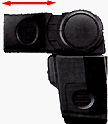 |
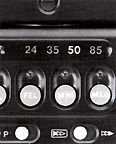 |
When the flash head is set correctly at one of the four click-stop positions, a zoom position setting of 24, 35, 50, or 85mm will be illuminated in the zoom mechanism position indicator on the back of the flash. |
The 300TL offers a zoom mechanism
which adjusts the flash coverage angle in order to use flash energy more effectively.
Note:
Do not choose a zoom
position setting larger than the focal length of the lens in use. Always be sure
to set the flash to a position equal to or smaller than the lens focal length. Otherwise,
exposure will NOT be uniform.
|
Focal lenght of the lens in use |
Zoom position setting |
|
24mm |
24 |
|
35mm |
35 or 24 |
|
50mm |
50, 35 or 24 |
|
85mm |
85, 50, 35 or 24 |
[1] Full Auto Mode
Flash photography is now as easy as program photography with the camera alone is. Just set the flash mode selector to "P" (Program). No matter what mode the camera is set for, it will automatically switch to the program mode and the flash will switch to the A-TTL mode. Even beginners can use the advanced techniques such as fill-in flash without fear of failure.
[2] A-TTL Mode
This mode is advantageous for general flash photography. Operation is fully automatic, under conditions ranging from total darkness to fill-in flash.
The shutter speed and the aperture are set automatically with the aid of near-infrared rays, etc., and the flash output is controlled by directly measuring the light coming through the lens and being reflected from the film surface. In cases such as fill-in flash, this A (Advanced)-TTL mode balances the exposure between the main subject and the background to prevent unnatural effects.
The light is measured through the lens so exposure is automatically compensated even in bounce flash photography and multiple flash photography.
[3] FEL (Flash Exposure Lock) Mode
With the world's first spot metering for flash photography, using the principle of spot metering, this mode gives correct exposure even when the main subject is not in the center of the viewfinder.
Before an exposure is made, the pre-flash is made by a 1/20th power. The light reflected from the main subject is spot-metered by the camera and the exposure level is stored into memory (effective for 30 seconds). When the actual exposure is made, the flash output is determined by this value. TTL flash photography is possible without being affected by the reflectivity of the film in use since the TTL control system of this mode does not use the reflection from the film surface.
It is also possible to independently control the exposure level for the main subject with the flash and the exposure level for the background with the ambient light, if the H/S control of the T90 is used with the FE lock mode.
[4] Manual Hi (M Hi) Mode / Lo (M Lo) Mode
In some cases, automatic flash may not be suitable for your subject. If, for instance, the subject's surroundings are bright white with strong reflections or if the main subject is small with a dark or distant background, the automatic flash exposure may be affected by the contrasting background. Incorrect exposure can be avoided by using the Manual Hi mode.
While the Manual Hi mode gives full flash intensity, the Manual Lo mode is used for fill-flash or to make the flash recycling time as short as possible. Flash intensity is 1/16th that of full flash and the guide number of the flash becomes 1/4th that of full flash.
Basic Flash Operation
[1] Full Auto Mode
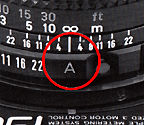 1) Make sure the aperture ring og the lens is set to the "A" mark. The shooting mode and the metering mode of the T90 may be on any setting. |
|
 |
|
| 3) Set the mode selector to the "P" position and make sure the P position confirmation lamp lights up. | 4) Compose the picture and focus the subject. |
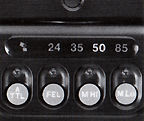 |
|
| 5) Make sure the pilot lamp lights up. The "/" mark in the viewfinder will come on at the same time as the pilot lamp. |
6) Press the shutter button halfway to activate the viewfinder information display. |
Note: If the subject is too far away, both the shutter speed and the aperture will blink in the viewfinder. In this case remove your finger from the shutter button and move closer to the subject, until when the shutter button is pressed again, both the shutter speed and the aperture value light up steadily. If you do not remove your finger from the shutter button, exposure will be incorrect since exposure is set and held on each time the shutter button is pressed halfway.
[2] A-TTL Mode
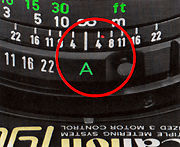 |
|
| 1) Make sure the aperture ring of the lens is set to the "A" mark. The metering mode of the T90 may be on any setting. |
2) Turn the main switch ON. ("|" mark) |
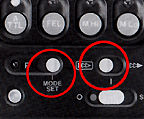 |
|
| 3) Set the mode selector to the Mode Set position. Set the sync position selector to the first curtain sync position. |
4) Set the control mode set button to the A-TTL mode and make sure the control mode confirmation lamp lights up. |
5) Compose the picture and focus the subject.
|
(A) With the T90 in the Program AE Modes
6) Make sure the pilot lamp lights
up.
7) Press the shutter button halfway to activate the viewfinder information.
8) Press the shutter button all the way to take the picture.
 |
Note: If the subject is too far away, both the shutter and the aperture will blink in the viewfinder. In this case, follow the note mentioned in the Full Auto Mode. |
(B) With the T90 in the Shutter Priority AE Modes
6) Use the electronic input dial of the T90 tc the shutter speed between 30 and 1/250 after considering what photographic effe desired.
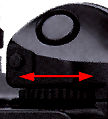 |
 |
Note: The shutter speed will be set to 1/250 sec automatically if set at a higher value. |
7) Make sure the pilot lamp lights up. 8) Press the shutter button halfway to activate viewfinder information. 9) Press the shutter button all the way to take the picture.
 |
|
(C) With the T90 in the Aperture Priority AE Modes
 |
 |
6) After considering which photographic effect is desired, set the lens aperture between the maximum and the minimum aperture using the electronic input dial of the T90. |
7) Make sure the pilot lamp lights up.
8) Press the shutter button halfway to activate the viewfinder information.
 |
9) Press the shutter button all the way to take the picture. |
Selective
Canon TTL Flash Models:-
300EZ | 300TL | 420EZ | 430 EZ | 480EG | 540EZ | other non-TTL Canon flash models
|
Back | to
300TL flash Instruction Manual Index Page
|
Back | Main
Index Page of Canon
T90
T-90 Camera Manual (Only available in HTML Format) (new) :| Canon
300TL Flash
; Canon A and T series SLR cameras. (new)
| Message Board |
for your Canon T90
SLR camera
| Message Board |
for your Canon optics in a shared environment
| Message Board |
Specifically for Dispose or Looking for Canon Photographic equipment
Lenses: FL | Canon
FDn lenses. | Early versions of FD lenses
Copyright © 2000. leofoo ®. MIR Web Development Team.
Credit: Mir MR Richard Yeow, Genera Manager of camera division, Canon Marketing. Kaipin who has spent quite sometime locate the Manual at the new Canon premises. Miss Wati/Mirza of FFM for their effort in helping to scan the original manual. Mr Chris Tutti of Canada for his earlier help. Dedicated to all the Canon T90 fans.
|
Home - Photography in Malaysia |
